Ballasted Roof Solar Racking Systems have revolutionized the installation of photovoltaic (PV) arrays on commercial and industrial flat roofs. Their design offers a non-penetrating solution, crucial for preserving the roof’s integrity and warranty.
The Core Principle: Using Weight, Not Penetration
The fundamental concept behind a ballasted Roof Solar Racking System is simple: gravity. Instead of drilling into the roof structure, the system uses inert weight—the ballast—to counteract the forces of nature, primarily wind uplift and, to a lesser extent, seismic forces.
These systems consist of several key components:
- Racking/Mounting Structure: Lightweight, corrosion-resistant frames (usually aluminum or galvanized steel) that hold the solar panels at the desired tilt angle. These frames are engineered to distribute the load evenly across the roof.
- Ballast Trays/Pans: Integrated or separate compartments within the racking structure designed to hold the ballast material.
- Ballast Material: Typically concrete blocks, pavers, or less commonly, gravel. The weight of this material is precisely calculated.
- Protective Mats/Pads: High-density rubber or foam pads placed beneath the racking and ballast to protect the roof membrane from abrasion and point loading.
The structural stability of the entire solar array depends on the ballast weight being greater than the maximum expected uplift force from wind.
Engineering for Stability: Wind and Load Calculations
The engineering of a ballasted Roof Solar Racking System is a meticulous process that goes far beyond simply setting weights on a roof. It involves complex calculations based on local building codes and standards.
1. Wind Uplift Analysis
Wind is the primary enemy of any rooftop solar installation. The uplift forces created by wind flowing over and around a building are highly dependent on:
- Building Height and Location: Taller buildings and those in open areas experience higher wind pressures.
- Roof Edge and Corner Zones: Wind speed and uplift pressure are significantly higher at the perimeter and corners of a roof compared to the field area. The ballast requirement will often be highest in these zones.
- Panel Tilt and Orientation: Higher panel tilt angles generally catch more wind, increasing the required ballast.
Sophisticated software and wind tunnel data are used to determine the exact ballast required for each specific location on the roof, ensuring the array remains stable under extreme weather conditions.
2. Structural Load Review
While non-penetrating, the ballasted system adds significant weight to the roof. A structural engineer must verify that the existing roof structure—including the deck, beams, and columns—can safely support the combined dead load (the weight of the racking, panels, and ballast) and the temporary live load (snow, ice, or maintenance personnel).
The design of the Roof Solar Racking Systems is crucial here, as it aims to spread the load over a larger surface area to keep the pounds per square foot (PSF) within the roof’s allowable limit.
Installation and Maintenance
The installation process for ballasted systems is generally faster and less invasive than penetrating systems.
- Roof Preparation: The area is cleaned, and protective mats are laid out to guard the roof membrane.
- Racking Assembly: The lightweight racking frames are assembled on the mats.
- Panel Integration: Solar panels are secured to the frames.
- Ballast Placement: The calculated amount of concrete blocks or other ballast material is placed into the designated trays. This is a critical step, as the correct weight distribution is essential for system integrity.
Because there are no roof penetrations, maintenance typically focuses on panel cleaning and inspection of the racking and ballast for any shifting, though movement is rare when the system is correctly engineered and installed.
Key Advantages of Ballasted Systems
Ballasted Roof Solar Racking Systems have become the preferred solution for flat roofs due to several compelling benefits:
| Feature | Advantage |
|---|---|
| Non-Penetrating | Preserves roof warranty and eliminates the risk of leaks associated with drilling holes. |
| Speed of Installation | No drilling or sealing is required, making for a faster deployment. |
| Flexibility | Allows for easier adjustments or relocation of the array in the future. |
| Minimal Impact | The absence of anchors reduces stress points on the roof structure. |
In summary, a ballasted Roof Solar Racking System effectively works by substituting structural anchors with carefully calculated, inert mass (ballast) to resist wind forces. This elegant engineering solution provides a secure, reliable, and roof-friendly way to harness solar energy on flat commercial rooftops.













